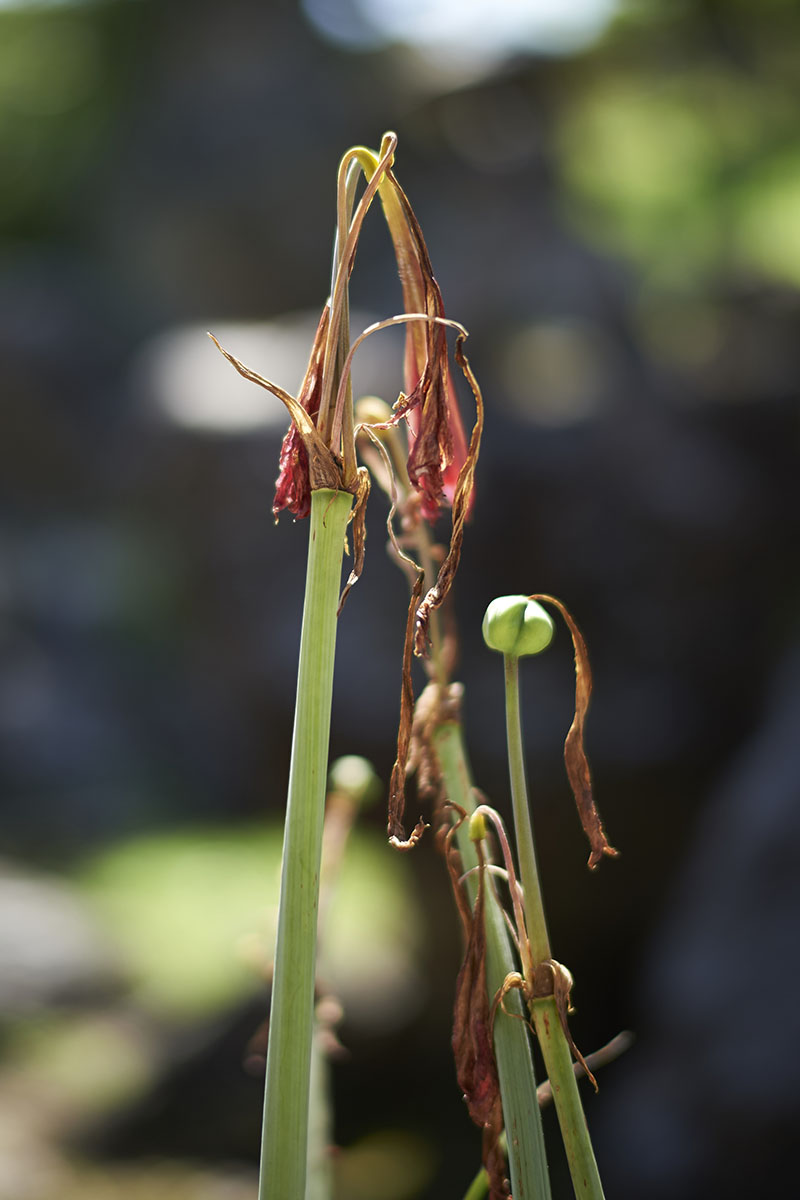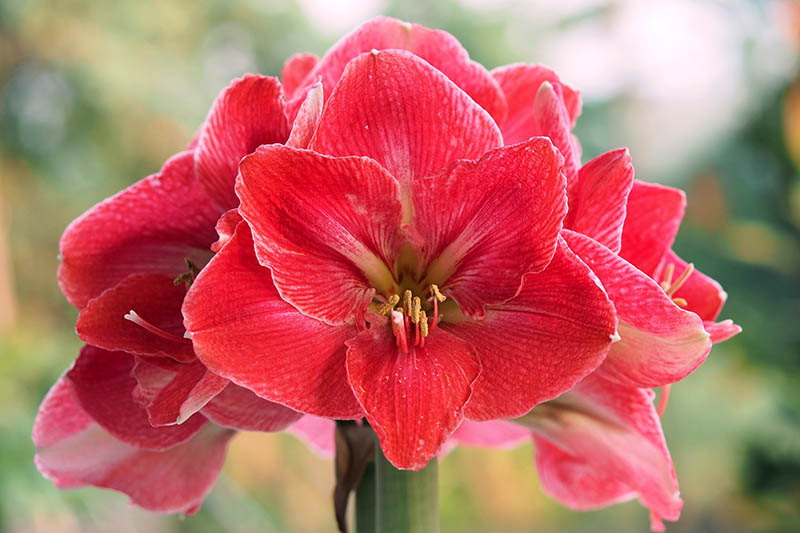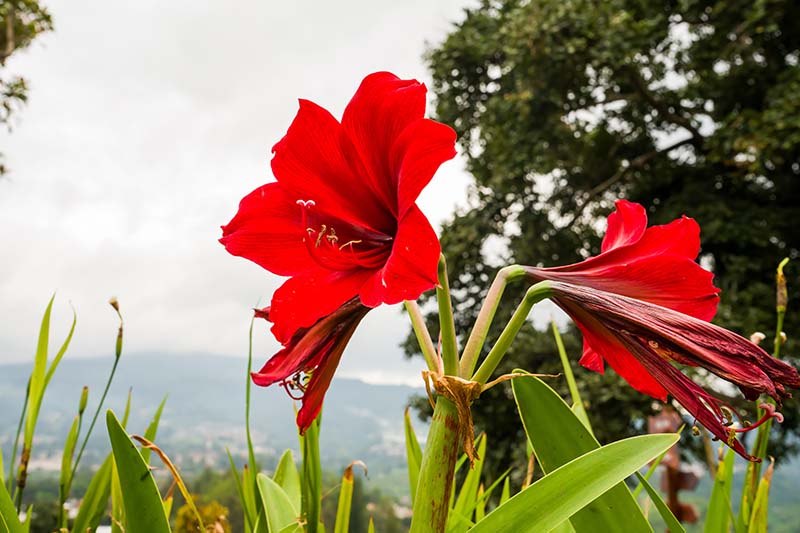This makes them ideal presents for gardening newcomers, and they make a colorful addition to holiday decor. However, even when they receive the best of care, amaryllis plants (Hippeastrum spp.) can occasionally suffer from diseases – one of the nastiest of which is southern blight. We link to vendors to help you find relevant products. If you buy from one of our links, we may earn a commission. Overwatering is common among inexperienced gardeners. If your holiday bulbs grow too damp in a warm home and the fungi are present, boom: You may suddenly have an outbreak of southern blight on your hands. Once this happens, there is not much you can do for a houseplant. And even if you live in a place warm enough to grow amaryllis out in your garden year-round, fungicides may fail to be effective. But there are some prevention options available to you. Here’s what I’ll cover:
What Is Southern Blight?
Southern blight is a lethal disease caused by the fungus Sclerotium rolfsii that can affect hundreds of types of plants, both edible and ornamental, including tomatoes, apples, and caladiums.
This disease is so named because it was once believed to be confined to warm tropical and subtropical locations. Today it is known to cause problems in gardens beyond these bounds, including northern regions of the US during warm, humid summers. The pathogen can persist in soil, mulch, and plant debris for many years, by producing sclerotia – resting structures that can survive temperatures as low as 14°F. These structures are the size of mustard seeds, so they can be difficult to detect. They start out white, before turning tan or brown and blending in with the soil. Just one of these structures is enough to cause a serious infection under favorable conditions. Devastating outbreaks often occur when heavy rains follow a period of hot, dry weather. Humidity is often low indoors, in homes where the heat is running in the winter. Combined with overwatering, if the fungi are present, your potted holiday bulbs may also be infected.
Symptoms
You might not realize that there is anything wrong with your amaryllis plant until the leaves turn yellow and wilt, and a sudden downturn in the health of your plant can seemingly happen overnight. Unfortunately, this is a sign that the disease is already in its late stages. Infection is most likely to occur in garden plants when temperatures reach 80 to 95°F during the day. Sunny and warm spots indoors, near a radiator or other source of heat, can also reach higher daytime temps than you might suspect. If you know what to look for before the telltale yellowing and collapsing foliage appears and examine the bulb of an infected plant, you will find brown lesions just below the surface of the soil. Rotting of the crown is another typical symptom of this disease. If you look closely, you might also find white fungal threads growing from the foliage down to the soil, or they could be interwoven in the surface of the bulb about an inch or two below the soil. The infection will eventually cause the bulb to rot, killing the plant.
Control Methods
If you are growing your amaryllis in pots, there isn’t anything you can do to cure a plant that has contracted southern blight disease, and wilted plants will not recover. If you discover symptoms that indicate the presence of this disease, quickly dispose of the plant and the soil, and take appropriate measures to prevent the infection from spreading. If you wish to reuse the pot it was growing in, do not do so without sterilizing it first. This type of fungus tends to persist in places where infected plants have grown. Austin Hagan, an Entomology and Plant Pathology Professor of Auburn University in Alabama, attributes most cases of southern blight in commercial nurseries to the reuse of unwashed containers, and poor sanitation. If you are growing amaryllis in the landscape, you should also bag any infected plants as well as the surrounding soil, and dispose of them in a landfill – and absolutely not in your compost pile. Starting at least a foot beyond the affected area, remove all plants and the surrounding soil extending out at least three inches in all directions, and dispose of them in the trash. When you are done, turn over any remaining soil eight to 12 inches deep, to bury any hidden sclerotia that remain. Short of killing them, this will at least help to shorten the amount of time that they can survive in the soil.
Prevention Tips
Many amaryllis bulbs used for holiday decorating only last one season in cold climates, and then they are disposed of.
If you live in a growing zone suitable for transplanting outdoors or hope to grow yours year-round as a houseplant, keep an eye out for symptoms. Never purchase bulbs that exhibit obvious signs of disease, and purchase bulbs from reputable sellers that are backed by a product guarantee or certified disease free whenever possible. Inspect bulbs for signs of disease before planting. Ensure that you use sterile potting soil and a container with adequate drainage if you are potting bulbs yourself. And keep in mind that this fungal infection in particular does not readily exhibit symptoms until after the foliage has emerged. If your bulbs arrive already potted, we do not recommend digging them up and checking for signs of disease as a preventive measure. Rather, do your best to provide the best possible conditions in your home for your plant’s growth, and avoid overwatering or exposure to high heat. Make sure your plants are healthy before you transplant them out to the garden, and dispose of them instead if they show symptoms to indicate the presence of this fungus. Do not reuse garden soil where sclerotia or other signs of this disease have been found in the past. Avoid planting healthy specimens in pots or areas of the garden that do not drain well, and ensure adequate spacing from other plants and structures to promote good air circulation. Fungicides may also be used as a preventive measure to protect the stems, root collar, and roots of your amaryllis from this fungus, particularly in areas known for having southern blight issues in the past. But these will not kill S. rolfsii after an infection has already taken hold. Keep in mind that the pathogen that causes southern blight disease is one of those types of fungi known to rapidly develop resistance to fungicides. You may have to consult local experts to determine what types of fungicides are still effective as preventative sprays to protect plants in your area. You can talk to your county extension agent for advice and recommendations suited to your region. Southern blight almost guarantees its survival by producing sclerotia that can persist in the soil for years. Since this disease is so difficult to treat, preventing its occurrence is your best bet if you grow amaryllis outside in your garden. Fortunately, with houseplants, it’s not as much of a concern.
When growing amaryllis indoors, be sure to purchase high-quality bulbs whenever possible, consider the location for placement in your home carefully, and avoid overwatering and high temperatures. If yours shows signs of this disease, dispose of it carefully to avoid potential spread to other plants or to your garden outside. This bulb won’t recover, but you can always try again next year. Have you lost an amaryllis to southern blight, or successfully produced one that’s healthy and thriving? Was it growing indoors in a pot, or outside? For more information about caring for amaryllis flowers, check out these guides next:
17 Awesome Amaryllis Varieties to Grow Indoors or Out How to Propagate Amaryllis Bulbs How to Grow Amaryllis (Hippeastrum) From Seed
© Ask the Experts, LLC. ALL RIGHTS RESERVED. See our TOS for more details. Uncredited photos: Shutterstock. With additional writing and editing by Allison Sidhu.




